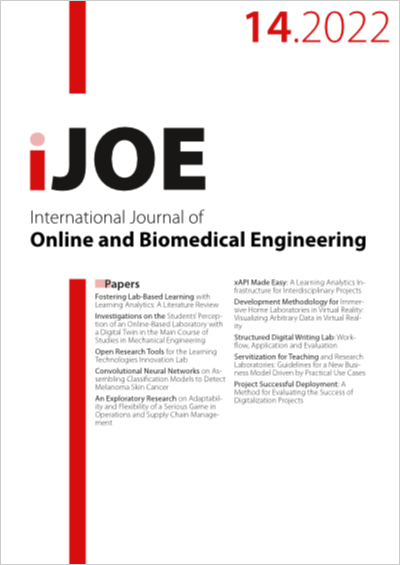Development Methodology for Immersive Home Laboratories in Virtual Reality
Visualizing Arbitrary Data in Virtual Reality
DOI:
https://doi.org/10.3991/ijoe.v18i14.35099Keywords:
Virtual Laboratory, Virtual Reality Laboratory, Fictitious Domain Method, Unreal Engine 4, Home Laboratory, Data Visualization, Fluid MechanicsAbstract
Although fluid mechanics should be an easy area of physics to learn due to the ubiquity of flows, many students already struggle to understand the basics. Unlike hands-on labs, this is where virtual labs can provide additional interactive visualizations to better facilitate and promote understanding of the fundamental phenomena. However, how can such laboratories be developed for engineering education relatively easily? This contribution presents a simple technical methodology to convert laboratory experiments into a virtual home laboratory. The basis is the representation of arbitrary data in virtual reality. The authors show on the example of a fluid mechanics laboratory experiment a simple numerical method to calculate the flow by using the so-called fictitious domain approach, a procedure to import CFD-calculated fluid-mechanical data into the Unreal engine 4 originally made for development of computer games. As a game engine, it offers high performance so that the virtual environment runs smoothly on ordinary computers without need of special hardware, so also VR-goggles are optionally. In the home laboratory, the flow can be influenced by setting the pressure gradient and we show how to display vector fields, particle motion, residence time, streamlines, information panels, and scalar fields in 3d representation and in arbitrarily set cut planes. Since many of the features cannot be displayed in a real lab, this contribution reflects some possibilities of the design principles of industry 4.0 in a virtual lab.
Downloads
Published
How to Cite
Issue
Section
License
Copyright (c) 2022 Konrad Boettcher, Alexander Behr, Claudius Terkowsky

This work is licensed under a Creative Commons Attribution 4.0 International License.


